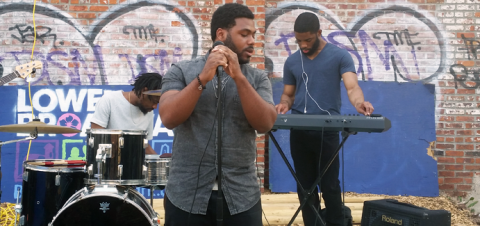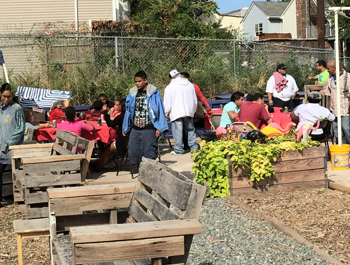Image

Ray Ocasio, Executive Director, La Casa De Don Pedro
Challenge: In Newark, New Jersey, the Lower Broadway neighborhood does not offer much open space for outdoor recreation and socializing. Nearly 20 percent of residents live in apartment buildings with no outdoor space. Meanwhile, there are a number of vacant lots that mar the atmosphere.
First, here's a little background on the Lower Broadway neighborhood of Newark, New Jersey: Lower Broadway is a 1.2-square-mile neighborhood located on the northern fringe of Newark's central business district. With more than 14,000 residents, Lower Broadway is one of the most diverse neighborhoods in the city. It remains a largely Hispanic community (51 percent vs 32 percent in Newark overall); however it now also has a wide mix of residents from Puerto Rico, Ecuador, the Dominican Republic and Mexico. The black population has also increased steadily and includes African-Americans as well as a growing number of West Africans.
One quarter of the residents are under the age of 18, and one out of every five households is headed by a female with children under the age of 18. The unemployment rate hovers around 14 percent.
Lower Broadway clearly has some challenges, but it is a neighborhood in the midst of transformation, with a lot of success stories. This one began during the NeighborWorks America's 2013 Community Leadership Institute, when Yolanda Vann, a member of the Lower Broadway Neighborhood Association, had lunch in a unique "common space" in Sacramento, CA. The space was located in a formerly "useless" lot between three restaurants, but had been transformed into a comfortable area where people could congregate, socialize and enjoy a meal. Vann immediately decided that the Lower Broadway neighborhood in Newark would benefit from a similar public space. Community leaders supported Vann's vision, and she and others set to work finding a lot that could be converted into a vibrant outdoor community space in Lower Broadway.
 Organizers encountered many challenges during the planning process, including some doubt about the feasibility and value of the vision, logistical hurdles, budget constraints and volunteer burnout. Nonetheless, Krystyna Soljan and Kevin Alonzo from La Casa De Don Pedro, with collaboration from the Lower Broadway Neighborhood Association, persevered and found creative ways to engage the community and motivate residents to dare to think big.
Organizers encountered many challenges during the planning process, including some doubt about the feasibility and value of the vision, logistical hurdles, budget constraints and volunteer burnout. Nonetheless, Krystyna Soljan and Kevin Alonzo from La Casa De Don Pedro, with collaboration from the Lower Broadway Neighborhood Association, persevered and found creative ways to engage the community and motivate residents to dare to think big.The result was a plan for a space that would host outdoor performances and other social activities in a format called My Front Porch. One of the first major steps was to acquire a permanent site. Eventually organizers identified a spot in the perfect location: 57 Crane St., a long-neglected, unsightly parcel of land—home to an old industrial building that had burned down 20 years earlier. The property was marred by large chunks of concrete, refuse, tall weeds and decades of accumulated debris, but it had lots of potential.
"Reclaiming" the lot was physically demanding. Some volunteers suffered burnout, but most persisted and came back after they'd had some time off.
The next step was to transform the lot into My Front Porch. With a limited budget, community involvement was essential. Nearby Barringer High School's wood shop students created seating for the venue, along with tables, a stage and raised plant beds. A variety of local organizations donated furniture and other supplies.
To build anticipation, a local band called Lot on 7th, which describes its music as "alternative hip-hop/neo-soul," began hosting open mic nights for musicians in Lower Broadway. Residents came out to listen; others brought instruments to perform. The concerts brought residents together.
When My Front Porch finally debuted, it transformed the neighborhood. Residents of Lower Broadway who'd rarely participated in community-driven activities were suddenly dancing, singing and eating together. Activities range from an open-mic stage, to movie showings, to kids' activities. The space is a safe haven for Newark residents. Seeing the smiles of the children and the glow in their eyes has been one of the most rewarding benefits of My Front Porch.
"I saw that lot for 15 years look like a mess, with weeds and debris and everything in there. When we got in there and cleaned it up, it became a really nice space," says Pamela Mclean, a Lower Broadway resident. "It was good to see everybody pitch in."
We've learned a few lessons along the way to this success:
- Plan ahead and conduct as much outreach as possible to recruit volunteers; this type of project needs many dedicated volunteers (otherwise your organizers get burned out!).
- When residents see volunteers working or playing in the space, they will generally join for a spell. In other words, "perform and they will come!" We met so many residents simply by spending hours in the space.
- Ask lots of questions; you may learn the most important lessons through informal interactions.

